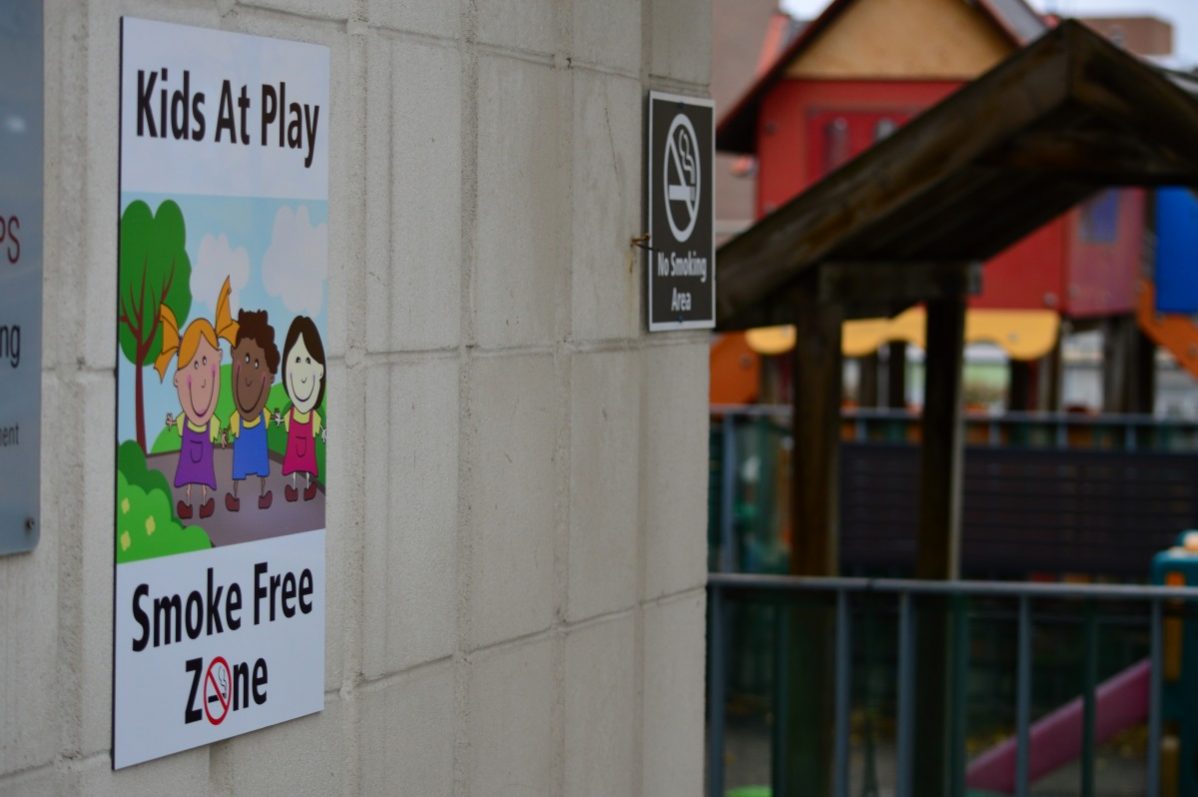College watching how smoke-free campus policy works at McMaster University
The child-care centre at Casa Loma has a second-hand smoke problem, and parents of children at the centre want the college to address it.
At issue are the outdoor areas around the centre’s playground and entrances where folks smoking cigarettes and other devices have made a habit of lighting up.
Tim Jackson, whose two-year-old daughter attends the child-care centre, has been working to get George Brown College (GBC) to deal with the smoking problem.
“The whole thrust of this for me is that my daughter deserves to go to a daycare that is a smoke-free environment,” he said.
Jackson has been organizing parents of children at the centre since 2016. He’s written letters to the college, had meetings with GBC president Anne Sado, and called Toronto bylaw officers in to enforce the law.
“My daughter had been hospitalized with an asthma attack before she went to this daycare and so when I found out about this issue, it’s very significant for me, for her and our family,” he said.
George Brown has taken steps to stop smoking near the child-care centre including putting up new signage, and increasing the security presence around the playground and entrances.
“I think actually parents have been quite appreciative of the efforts we’ve put into this in the last few months,” said Adrienne Galway, GBC’s special advisor to the president.
According to Galway, part of the problem is that the college can’t issue tickets to discourage smoking in prohibited spaces. Another issue is that every semester, there are new students who smoke where they shouldn’t.
“The start of the school year is always a challenge because it’s a new group of students, so it’s that education effort at the beginning to remind them that there is daycare there, that they can’t smoke in those areas,” Galway said. “We’ve been putting a lot of effort into that and it has gotten better, so I think parents understand the challenges that we’ve got in enforcing it and constantly reminding people.”
Galway added that the college intends to add more security patrols again at the beginning of the January semester.
But smoking around the area remains an issue. On four separate occasions this month, staff from The Dialog observed smoking taking place on the stairs near the playground, with security present nearby.
Licensed child-care centres and playgrounds are covered under the Smoke-Free Ontario Act, which prohibits smoking indoors at these facilities and within 20 metres of a playground.
Because the act defines playgrounds as areas which the public regularly has access to, Casa Loma’s outdoor playground with its fence separating the kids from students does not fall under the protections of the act.
“It’s very frustrating that there’s so many laws to protect people from second-hand smoke in various kind of environments, including kids on sports fields and things like that, but there’s nothing to specifically protect these vulnerable children,” said Jackson.
Jackson added that the he and other parents are appreciative about the addition of security patrols, but he is anxious that without an articulated policy, guards might stop monitoring the playground.
“It would be great if they addressed that uncertainty by articulating a plan,” he said.
George Brown’s no-smoking policy prohibits smoking inside all buildings, sheltered alcoves, and loading dock entrances, as well as within nine metres of any entrance and the Casa Loma child care centre’s outdoor playground.
The policy states that with repeated violations the college could expel students if “other measures in the progressive disciplinary process are unsuccessful.”
In September, McMaster University announced plans to go 100 per cent smoke free in January 2018. The University of Toronto and Western have announced similar intentions.
Galway said that George Brown is also considering a move to make its campuses smoke free, but is waiting to see how things develop at McMaster first.
Jackson thinks making Casa Loma smoke-free would be healthier for children, staff and students at the campus.
“(A smoke-free) policy would be simple, easy to understand and to comply with” he said. “It’s been done elsewhere, on other campuses, and with other institutions, so templates are available.”
According to Health Canada there is no safe level of tobacco smoke. Second-hand smoke contains the same 4,000 chemicals that are inhaled by a smoker. Of these, at least 70 contain chemicals that cause cancer.
Children and babies are especially vulnerable to second-hand smoke because their lungs are less resilient and they breathe more quickly than adults. Exposure to second-hand smoke increases the risks of asthma, pneumonia, bronchitis and sudden infant death syndrome.



